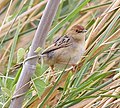| Image | Common name | Scientific name | Distribution |
|---|
 | Red-faced cisticola | Cisticola erythrops | Sub-Saharan Africa (except southern and Horn of Africa) |
 | Singing cisticola | Cisticola cantans | Sub-Saharan Africa |
 | Whistling cisticola | Cisticola lateralis | African tropical rainforest |
 | Trilling cisticola | Cisticola woosnami | Zambia, Tanzania, DR Congo, western Kenya |
 | Chattering cisticola | Cisticola anonymus | central Africa |
 | Bubbling cisticola | Cisticola bulliens | western Angola |
 | Hunter's cisticola | Cisticola hunteri | Kenya and northern Tanzania |
 | Chubb's cisticola | Cisticola chubbi | Western High Plateau and Albertine rift montane forests |
| - | Kilombero cisticola | Cisticola bakerorum | Tanzania |
| - | Black-lored cisticola | Cisticola nigriloris | Tanzania |
 | Rock-loving cisticola | Cisticola aberrans | Sub-Saharan Africa |
| - | Huambo cisticola | Cisticola bailunduensis | Angola |
 | Rattling cisticola | Cisticola chiniana | Sub-Saharan Africa (except western and southern Africa) |
| - | Boran cisticola | Cisticola bodessa | Eritrea, Ethiopia and Kenya |
 | Churring cisticola | Cisticola njombe | Tanzania and northern Malawi |
 | Ashy cisticola | Cisticola cinereolus | East Africa |
| - | Tana River cisticola | Cisticola restrictus | Kenya |
 | Tinkling cisticola | Cisticola rufilatus | central-southern Africa |
 | Grey-backed cisticola | Cisticola subruficapilla | Namibia and South Africa |
 | Wailing cisticola | Cisticola lais | southern and eastern Afromontane |
| - | Lynes's cisticola | Cisticola distinctus | Kenya |
 | Rufous-winged cisticola | Cisticola galactotes | southeastern Africa |
 | Winding cisticola | Cisticola marginatus | north/central Sub-Saharan Africa |
| - | Coastal cisticola | Cisticola haematocephalus | coastal East Africa |
| - | White-tailed cisticola | Cisticola anderseni | Tanzania |
| - | Ethiopian cisticola | Cisticola lugubris | Ethiopia |
 | Luapula cisticola | Cisticola luapula | Zambia and adjacent areas |
 | Chirping cisticola | Cisticola pipiens | Zambia, Angola and southern DR Congo |
| - | Carruthers's cisticola | Cisticola carruthersi | Rwenzori and northern Lake Victoria region |
 | Levaillant's cisticola | Cisticola tinniens | southern Sub-Saharan Africa |
 | Stout cisticola | Cisticola robustus | western and eastern Afromontane |
 | Aberdare cisticola | Cisticola aberdare | Kenya |
 | Croaking cisticola | Cisticola natalensis | Sub-Saharan Africa |
 | Red-pate cisticola | Cisticola ruficeps | Lake Chad to Eritrea and northern Uganda |
 | Dorst's cisticola | Cisticola guinea | western Africa |
 | Tiny cisticola | Cisticola nana | East Africa |
| - | Short-winged cisticola | Cisticola brachypterus | Sub-Saharan Africa (except southern Africa) |
| - | Rufous cisticola | Cisticola rufus | western Africa |
 | Foxy cisticola | Cisticola troglodytes | western CAR to Ethiopia |
 | Neddicky | Cisticola fulvicapilla | southern half of Sub-Saharan Africa |
 | Long-tailed cisticola | Cisticola angusticauda | Zambia and Tanzania |
 | Black-tailed cisticola | Cisticola melanurus | northern Angola and south-western DRC |
 | Zitting cisticola | Cisticola juncidis | Afrotropics, southern Palearctic and northern Australia |
| - | Socotra cisticola | Cisticola haesitatus | Socotra |
 | Madagascar cisticola | Cisticola cherina | Seychelles and Madagascar |
 | Desert cisticola | Cisticola aridulus | Arid regions of Sub-Saharan Africa |
 | Cloud cisticola | Cisticola textrix | Angola, western Zambia and southern Africa |
 | Black-backed cisticola | Cisticola eximius | sparsely present across the Sudan (region), the Congo and western Kenya |
 | Dambo cisticola | Cisticola dambo | the Congo, southern DRC, northern Angola and Zambia |
 | Pectoral-patch cisticola | Cisticola brunnescens | Adamawa Massif, Gabon, the Congo and highlands of East Africa |
 | Pale-crowned cisticola | Cisticola cinnamomeus | the Congo, Tanzania to eastern South Africa |
 | Wing-snapping cisticola | Cisticola ayresii | highlands of southern Africa |
 | Golden-headed cisticola | Cisticola exilis | Indomalaya and western Oceania |
|









































